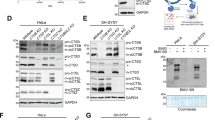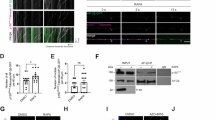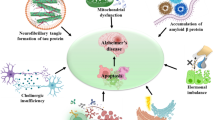Abstract
Apoptosis is a conserved active cellular mechanism occurring under a range of physiological and pathological conditions. In the nervous system, apoptosis plays crucial roles in normal development and neuronal degenerating diseases. Various deleterious conditions, including accumulation of the mutant proteins in the endoplasmic reticulum (ER) and inhibition of ER to Golgi transport of proteins, may result in apoptosis. In this study, we examined the downstream events of apoptosis in differentiated PC 12 cells under ER stress induced by brefeldin A, an inhibitor of ER to Golgi protein transport. Activation of NF-κB and degradation of I-κB were observed within 2 hours, followed by up-regulation of GRP78 protein level in treated cells. Caspase-12 only appeared around 24 hours after brefeldin A treatment, coincident with cell nuclei fragmentation. These results suggest that neuronal apoptosis may be induced by ER stress through a NF-κB and caspase related pathway.
Similar content being viewed by others
REFERENCES
Huxford, T., Huang, D. B., Malek, S., and Ghosh, G. 1998. The crystal structure of the I-kBa/NF-kB complex reveals mechanisms of NF-kB inactivation. Cell 95:759-770.
Jacobs, M. D. and Harrison, S. C. 1998. Structure of an IkBa/ NF-kB complex. Cell 95:749-758.
Jobin, C. and Sartor, R. B. 2000. The I-kB/NF-kB system: A key determinant of mucosal inflammation and protection. Am. J. Physiol. (Cell Physiol.) 278:C451-C462.
Brown, K., Gerstberger, S., Carlson, L., Franzoso, G., and Siebenlist, U. 1995. Control of I-kB proteolysis by site-specific, signal-induced phosphorylation. Science 267:1485-1488.
Baeuerle, P. A. 1998. I-kB/NF-kB structures: At the interface of inflammation control. Cell 95:729-731.
Ballard, D. W., Kixon, E. P., Peffer, N. J., Bogerd, H., Doerre, S., Stein, B., and Greene, W. C. 1992. The 65-kDa subunit of human NF-kB functions as a potent transcriptional activator and a target for v-Rel-mediated repression. Proc. Natl. Acad. Sci. USA 89:1875-1879.
Baroes, P. J. and Karin, M. 1997. Nuclear factor-kB-a pivotal transcription factor in chronic inflammatory diseases. N. Engl. J. Med. 336:1066-1071.
Muzio, M., Chinnaiyan, A. M., Kischkel, F. C., O'Rourke, K., Shevchenko, A., Ni, J., Scaffidi, C., Bretz, J. D., Zhjang, M., Gentz, R., Mann, M., Krammer, P. H., Peter, M. E., and Kixit, V. M. 1996. FLICE, a novel FADD-homologous ICE/CED-3-like protease, is recruited to the CD95 (Fas/APO-1) death-inducing signaling complex. Cell 85:817-827.
Boldin, M. P., Goncharov, T. M., Goltsev, Y. V., and Wallach, D. 1996. Involvement of MACH, a novel MORT1/FADDinteraction protease, in Fas/APO-1 and TNF receptor-induced cell death. Cell 85:803-815.
Li, P., Nijhawan, D., Budihardjo, I., Srinivasula, S. M., Ahmad, M., Alnemri, E. S., and Wang, X. 1997. Cytochrome c and dATP-dependent formation of Apaf-1/caspase-9 complex initiates an apoptotic protease cascade. Cell 91:479-489.
Nakagawa, T., Zhu, H., Morishima, N., Li, E., Xu, J., Yankner, B. A., and Yuan, J. 2000. Caspase-12 mediates endoplasmicreticulum-specific apoptosis and cytotoxicity by amyloid-b. Nature 403:98-103.
Kaufman, R. J. 1999. Stress signaling from the lumen of the endoplasmic reticulum: Coordination of gene transcriptional and translational controls. Genes Dev. 13:1211-1233.
Yoneda, T., Imaizumi, K., Oono, K., Yui, D., Gomi, F., Katayama, T., and Tohyama, M. 2001. Activation of caspase-12, an endoplastic reticulum (ER) resident caspase, through tumor necrosis factor receptor-associated factor 2-dependent mechanism in response to the ER stress. J. Biol. Chem. 276: 13935-13940.
Liu, X. W., Gong, L. J., Guo, L. Y., Katagiri, Y., Jiang, H., Wang, Z. Y., Johnson, A. C., and Guroff, G. 2001. The Wilms' tumor gene product WT1 mediates the down-regulation of the rat epidermal growth factor receptor by nerve growth factor in PC 12 cells. J. Biol. Chem. 276:5068-5073.
Kao, S., Jaiswal, R. K., Kolch, W., and Landreth, G. E. 2001. Identification of the mechanisms regulating the differential activation of the MAPK cascade by epidermal growth factor and nerve growth factor in PC12 cells. J. Biol. Chem. 276: 18169-18177.
Li, C. F., Browder, W., and Kao, R. L. 1999. Early activation of transcription factor NF-kB during ischemia in perfused rat heart. Am. J. Physiol. (Heart and Circulatory Physiol.) 276: H543-H552.
Kakimuaa, J., Kitamura, Y., Taniguchi, T., Shimohama, S., and Gebicke-Haerter, P. J. 2001. Bip/GRP78-induced production of cytokines and uptake of amyloid-b(1-42) peptide in microglia. Biochem. Biophys. Res. Commun. 281:6-10.
Li, C. H., Dai, R., and Longo, D. L. 1995. Inactivation of NF-kB inhibitor I-kB: Ubiquitin-dependent proteolysis and its degradation product. Biochem. Biophys. Res. Commun. 215:292-301.
Palombella, V. J., Rando, O. J., Goldberg, A. L., and Mannatis, T. 1994. The ubiquitin-proteasome pathway is required for processing the NF-kB1 precursor protein and the activation of NFkB. Cell 78:773-785.
Scherer, K. C., Brockman, J. A., Chen, Z., Maniatis, T., and Ballard, D. W. 1995. Signal-induced degradation of IkBa requires site-specific ubiquitination. Proc. Natl. Acad. Sci. USA 92:11259-11263.
Gow, A. and Lazzarini, R. A. 1996. A cellular mechanism governing the severity of Pelizaeus-Merzbacher disease. Nat. Genet. 13:422-428.
Baerwald, K. D., Corbin, J. G., and Popko, B. 2000. Major histocompatibility complex heavy chain accumulation in the endoplasmic reticulum of oligodendrocytes results in myelin abnormalities. J. Neurosci. Res. 59:160-169.




